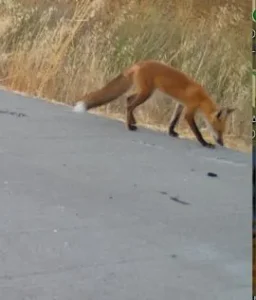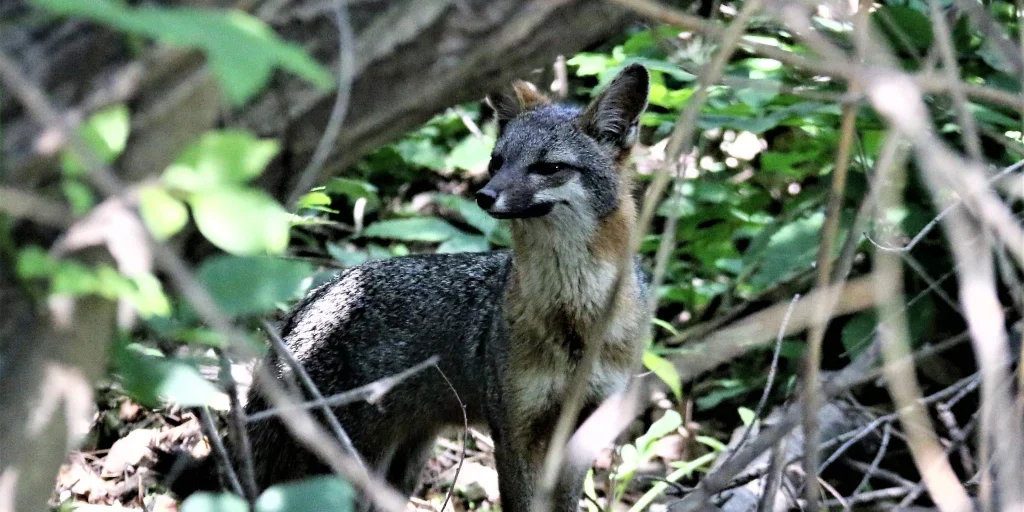Red Fox Invasion
by William C. Leikam
President, CEO & Co-founder, Urban Wildlife Research Project
Red (Vulpes vulpes) and gray foxes (Urocyon cinereoargenteus) don’t get along and for several reasons. They vie for the same food supply. Because they feed on the same critters, there’s always the fear for the gray foxes that there will not be enough food to go around and that puts them into a stress mode. When either the red or the gray foxes have pups, they will prey on those pups. Since Laimos and Big Eyes were the first to come into the region, they staked out their home range and claimed the territory as their own. However, in October 2019, about eight months after claiming their territory, a young female with a floppy tagged ear showed up in Laimos & Big Eyes home range. We named her Flop. After more than a month of chasing and fighting with Flop, Laimos and Big Eyes held their ground and successfully chased her from their territory.
 In that case they were aggressive. In one of the videos taken between camera #2 which is located near the ditch and camera #4 which is just 100 feet to the east, a red fox passed camera #4. In the next 30 second video the two foxes Laimos and Big Eyes are right behind the red fox. The two hike their tails, an signal that they are ready for a fight. They run after the red fox, a sure sign that they are trying to chase these red foxes out from their territory, but week after week the red foxes remain and lately there has been a change in the two gray fox’s behavior: Laimos and Big Eyes move before the trail cameras with a sense of trepidation and extreme caution.
In that case they were aggressive. In one of the videos taken between camera #2 which is located near the ditch and camera #4 which is just 100 feet to the east, a red fox passed camera #4. In the next 30 second video the two foxes Laimos and Big Eyes are right behind the red fox. The two hike their tails, an signal that they are ready for a fight. They run after the red fox, a sure sign that they are trying to chase these red foxes out from their territory, but week after week the red foxes remain and lately there has been a change in the two gray fox’s behavior: Laimos and Big Eyes move before the trail cameras with a sense of trepidation and extreme caution.
Scat Wars?
 Recently, as of July 23rd 2022, there has emerged what I’ve come to call the Scat Wars between the red and the gray foxes. Here I need to explain a bit about the fox’s use of scat. Gray foxes defecate at will. They do not have to wait for an urge. Their scat contains a strong rather offensive smelling odor. This odor is important in that it carries important information out across the landscape. Scat placed in the middle of the road/trail is an important home range marker. The information carried within is that this territory belongs to Laimos and his mate Big Eyes.
Recently, as of July 23rd 2022, there has emerged what I’ve come to call the Scat Wars between the red and the gray foxes. Here I need to explain a bit about the fox’s use of scat. Gray foxes defecate at will. They do not have to wait for an urge. Their scat contains a strong rather offensive smelling odor. This odor is important in that it carries important information out across the landscape. Scat placed in the middle of the road/trail is an important home range marker. The information carried within is that this territory belongs to Laimos and his mate Big Eyes.
Since they defecate at will, this allows them to intentionally put their scat in a specific location. It is from this that we begin to see the scat wars emerge. Lately Laimos and Big Eyes have gone into their summer vegetarian diet. Their scat consists of berry seeds such as those from the Italian buckthorn bush while the red foxes continue to feed on rodents and cottontail rabbits and their scat is a solid tubular feces. Two distinct feces.
During the latter part of July, the gray foxes have been leaving their scat on top of the red fox’s scat, thus sending the message, “We own this territory, not you and we show this by defecating on top of yours sending a clear message that this is ours.” To date I have not seen the inverse of this, i.e., the red foxes leaving any of their scat on top of the gray fox scat. That may be because the red foxes know that they have trespassed and thus they cannot claim any part of the territory. They have no defense.
Gray Foxes General Health
These two foxes appear to be in good health. The previous indication that one of them may have worms has not proven to be the case.
Total Numbers of Gray Foxes in the Palo Alto Baylands Nature Preserve
As of this date, we have two adult gray foxes living in the Palo Alto Baylands Nature Preserve.
Section II
Update for the Urban Wildlife Research Project
A new video documentary about my work with the foxes and produced at Stanford University can be watched here: https://www.youtube.com/watch?v=16bByDVEuKI&ab_channel=UrbanWildlifeResearchProject
Bill’s new book The Road to Fox Hollow has been released and can be found at Barnes & Noble Booksellers and directly from the publisher Di Angelo Publications at https://www.diangelopublications.com/books/the-road-to-fox-hollow. This is your best deal.
Dr. Marc Bekoff has an interview with Bill and that can be accessed at The Social and Emotional Lives of Urban Gray Foxes .
Bay Nature Magazine – How to be a Fox, the article about Bill and his ethological approach to his study of the gray fox is online here: https://baynature.org/article/how-to-be-a-fox/ Many are calling this a major article in the wildlife press.
BE SURE TO check out our YouTube Channel for some incredible wildlife videos at https://www.youtube.com/channel/UC5ujc7p8dU1-O5AbPAWz2_Q and our Facebook page.
See Discipline Raccoon Style here: https://www.youtube.com/watch?v=rdZbMGlkzEk
Bill has an additional live event coming up at Safari West in October. He will be live at Safari West https://www.safariwest.com/ in the Elephant Room.
Undoubtedly the best Radio interview ever – KALW (PBS program Crosscurrents) – by Sofie Kodner during December 2020 – Broadcast 1/11/2021 5:00 PM. Check it out here https://www.kalw.org/post/bay-area-wildlife-habitats-are-disappearing-fox-guy-has-plan
You can access Bill’s PowerPoint presentation Corridors & Connections: Sustaining the Health of All Wildlife presented during the October 24th P-22 Urban Wildlife Festival here: https://www.youtube.com/watch?v=Dh4MQL1D1Cc
NEW – To find out more about us, search Urban Wildlife Research Project, UWRP, gray foxes, wildlife connection, linkages, corridors and several documentaries including the video clips.
Section III
Gray Fox, Baylands Goals
Within the permit that allows the Urban Wildlife Research Project to conduct its study of the behavior of the gray fox at the Palo Alto Baylands Nature Preserve, the objectives covered area:
- Monitoring of urban gray fox Denning sites in Palo Alto Baylands.
This is being accomplished during the period when the gray foxes use a den site. It is one of the prime locations for gathering most of the behavioral data of the litter and for adults alike.
- Assessment of status and population trends of Baylands urban gray foxes
Since January 2019 a pair of resident gray foxes have claimed territory at the Palo Alto Baylands Nature Preserve.
- Identification of habitat features that promote the presence of urban gray foxes
After considering this and talking with people who know how to restore habitats, we need to assess what kinds of plants, including the Alkaline Salt Bush, would grow best along the edge of the saltwater channel and alongside the marsh. We need to grow a permanent habitat that contains the corridors and plant it as soon as possible. We’ll keep an eye on this as this is a critical link between the southern region of the Baylands and the northern region.
- Assessment of reproductive success and identification of factors that promote successful reproduction
Open up the pinch-point along Matadero Creek by developing thickets that link one area to another, instead of the present “islands”.
- Identification and assessment of possible dispersal travel routes.
Presently there can only be guesses as to dispersal travel routes. We intend to make this important question much more concrete when we attain our collaring/take/capture permit from the Department of Fish & Wildlife.




